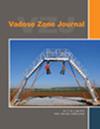模拟未扰动土芯的裸土蒸发--在 X 射线 µCT 测定的土壤宏观结构上使用 HYDRUS 3D 仿真
IF 2.8
3区 地球科学
Q3 ENVIRONMENTAL SCIENCES
引用次数: 0
摘要
土壤水的蒸发不仅取决于气候条件、土壤表面粗糙度、土壤质地和土壤水力特性,还取决于土壤的宏观结构。蒸发的特点是,在假定土壤质地和结构均质的情况下,确定的土壤体积中的水分随时间的变化而损失。在本技术说明中,我们研究了通过 X 射线计算机断层扫描确定结构特征 ≥480 µm 的 250 cm3 土芯蒸发过程三维建模的潜力和局限性。为此,我们使用等温理查兹方程作为主要控制方程,同时考虑等温蒸汽流。我们使用 HYDRUS 3D 模拟了两个蒸发实验,它们的土壤质地相同,但宏观结构(即分为土壤基质和充满空气的空隙的体素的空间排列)却截然不同,分别是耕地和非耕地草原土壤。在这两种模拟中,我们都将潜在蒸发率固定为实验蒸发率,并以 10 分钟间隔连续记录的两个深度(1.25 厘米和 3.75 厘米)的测量母势数据来评估模拟结果。结果表明,裸露土壤蒸发模拟能够预测张力计的动态和整个 7 天实验时间内的水分损失。模拟提供了含水量和流速随时间变化的独特空间信息,这对于研究充满空气的大孔隙、土壤基质的宏观连通性和水动力学对土壤蒸发的影响非常重要。本文章由计算机程序翻译,如有差异,请以英文原文为准。
Simulating bare soil evaporation for undisturbed soil cores—Using HYDRUS 3D simulation on X‐ray µCT determined soil macrostructures
Evaporation of soil water depends not only on climatic conditions, soil surface roughness, soil texture, and soil hydraulic properties but also on the soils’ macrostructure. Evaporation is characterized by water losses over time for a defined soil volume, where soils are assumed to be homogeneous in texture and structure. In this technical note, we investigated the potential and limitations of 3D modeling of evaporation processes on 250 cm3 soil cores with structural features ≥480 µm determined by X‐ray computed tomography. For this, we used isothermal Richards equation as the main governing equation, accounting also for isothermal vapor flow. We simulated two evaporation experiments with same soil texture but contrasting macrostructures, that is, the spatial arrangement of voxels classified as soil matrix and air‐filled voids, of a ploughed and non‐ploughed grassland soil with HYDRUS 3D. In both simulations, we fixed the potential evaporation rates to the experimental rates and evaluated simulation results with measured matric potential data at two depths (1.25 cm and 3.75 cm) continuously recorded at 10 min intervals. We could show that the simulations of bare soil evaporation were able to predict the tensiometer dynamics and water losses for the full experimental time of 7 days. The simulation provided unique spatial information of water content and flow velocities as a function of time, which are important when studying the effect of air‐filled macropores, macro‐connectivity of soil matrix, and water dynamics on soil evaporation.
求助全文
通过发布文献求助,成功后即可免费获取论文全文。
去求助
来源期刊

Vadose Zone Journal
环境科学-环境科学
CiteScore
5.60
自引率
7.10%
发文量
61
审稿时长
3.8 months
期刊介绍:
Vadose Zone Journal is a unique publication outlet for interdisciplinary research and assessment of the vadose zone, the portion of the Critical Zone that comprises the Earth’s critical living surface down to groundwater. It is a peer-reviewed, international journal publishing reviews, original research, and special sections across a wide range of disciplines. Vadose Zone Journal reports fundamental and applied research from disciplinary and multidisciplinary investigations, including assessment and policy analyses, of the mostly unsaturated zone between the soil surface and the groundwater table. The goal is to disseminate information to facilitate science-based decision-making and sustainable management of the vadose zone. Examples of topic areas suitable for VZJ are variably saturated fluid flow, heat and solute transport in granular and fractured media, flow processes in the capillary fringe at or near the water table, water table management, regional and global climate change impacts on the vadose zone, carbon sequestration, design and performance of waste disposal facilities, long-term stewardship of contaminated sites in the vadose zone, biogeochemical transformation processes, microbial processes in shallow and deep formations, bioremediation, and the fate and transport of radionuclides, inorganic and organic chemicals, colloids, viruses, and microorganisms. Articles in VZJ also address yet-to-be-resolved issues, such as how to quantify heterogeneity of subsurface processes and properties, and how to couple physical, chemical, and biological processes across a range of spatial scales from the molecular to the global.
 求助内容:
求助内容: 应助结果提醒方式:
应助结果提醒方式:


